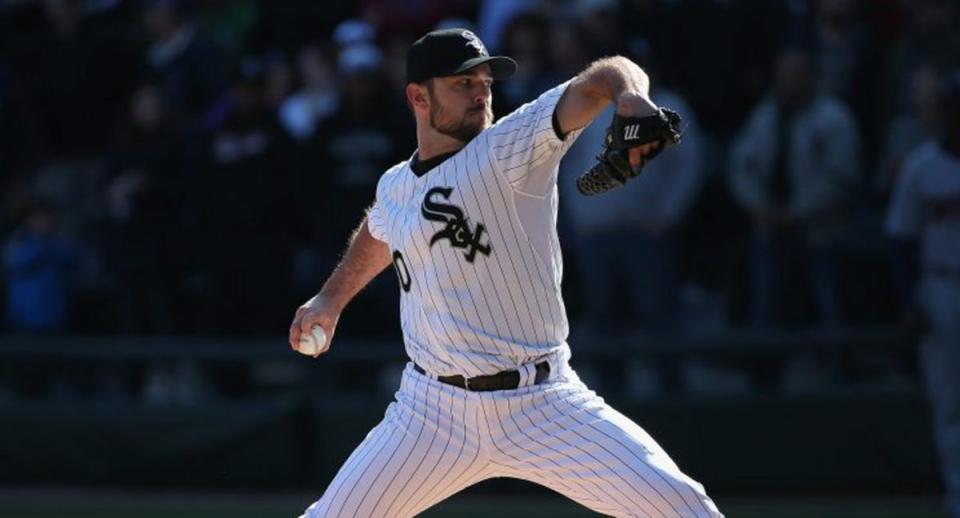Why the Robertson-to-Blue Jays rumour doesn't add up

Chicago White Sox closer David Robertson is simultaneously the exact sort of player the Toronto Blue Jays could use and the type they are unlikely to acquire.
Over weekend, the hot rumour – reported by Nick Cafardo of the Boston Globe – was that the Blue Jays had engaged in trade talks with Chicago about the 31-year-old reliever, who’s apparently “more than available.” It’s an idea that certainly isn’t without merit on first glance.
The White Sox have been in full teardown mode all offseason and have little use for a top-flight veteran reliever. The Blue Jays, meanwhile, have an outstanding closer in Roberto Osuna, but their other high-leverage right-handers are 40-year-old Jason Grilli, and Joe Biagini, who hadn’t pitched above Double-A at this time last year. They are a veteran group with a win-now mentality and a bullpen in need of reinforcements.
Robertson would be an excellent bridge to Osuna, a role he served with distinction while setting up Mariano Rivera during his time with the New York Yankees. Last year was his worst season since 2010, and he was still worth a full Win Above Replacement per FanGraphs – good for 41st among all relievers. Over the last six seasons, he’s baseball’s fourth-best reliever by WAR. There isn’t a better bullpen arm out there in free agency or on the known trade market.
Where this train gets derailed is the issue of compensation. Although Alex Anthopoulos became something of a local folk hero by repeatedly trading prospects for veterans, the acquisition of well-compensated players in their thirties is a very difficult act to pull off.
Robertson is a perfect example, in fact. Prior to the 2015 season, he signed a four-year deal worth $48 million in free agency. Presumably, he signed that contract because it was the highest amount of money offered to him – or at least close to it. That means most of the league felt Robertson was not worth that amount of money.
Therefore, if you want to trade for a player like Robertson, not only are you agreeing to pay a salary you likely found unpalatable at the time it was agreed to – you’re also giving away potentially valuable prospects for the privilege. It’s an issue Blue Jays general manager Ross Atkins touched on during an interview with Naylor and Landsberg on TSN Radio last Monday (h/t Andrew Stoeten), while discussing stated goal of making the team younger:
How you do that is you don’t trade your prospects. You don’t make your team younger by going into free agency — the one way you do it is you don’t trade the bulk of your double-A and triple-A players to acquire 32-year-olds — or whatever their age is. So our strategy to stay younger, and more athletic, and more agile, and to keep and balance is to use cash instead of players.
It could be argued that based on the team’s additions of Jose Bautista (36), Kendrys Morales (33), and Steve Pearce (33) this offseason, Atkins isn’t the foremost authority on making a team younger – but he makes a good point. By and large, if you’re looking to add veteran talent, the best way to do it is to open your wallet in free agency rather than taking on significant salary and shipping out prospects in a trade.
As a result, there are really two ways a Blue Jays-White Sox deal for Robertson could go down:
The White Sox eat the vast majority of Robertson’s salary and get a strong prospect return from the Blue Jays.
The right to have Robertson on your team for the next two seasons is certainly not worth the $25 million he’s owed, plus some of your organization’s best prospects. However, if you could have the relief ace at a minuscule salary that could be worth ponying up for.
Unfortunately for the Blue Jays, it’s hard imagine what exactly “ponying up” would look like. Keith Law of ESPN recently ranked the team’s farm system 21st in the major leagues. While the system isn’t totally bereft of talent, depth is an issue. Names like Vladimir Guerrero Jr., Sean Reid-Foley, Anthony Alford, and Richard Urena probably shouldn’t be on the table for a reliever, and beyond that it’s hard to see what would compel the White Sox to pay Robertson a significant amount of money to pitch for Toronto.
2. The Blue Jays take on the entirety of Robertson’s salary and the White Sox get a modest prospect return.
If the Blue Jays need to pay the remainder of Robertson’s backloaded deal, they simply aren’t forking over their top young talent. At the very least, they aren’t giving up guys who are close to making a major-league impact.
The problem here is that salary relief isn’t nearly as valuable to the White Sox as prospect capital. If they move Robertson, it’s not as if they’ll pivot and go for a pricey veteran in another deal. Also, estimates of the Blue Jays current payroll sits at $155 million, while estimates of their eventual budget range from $160-165 million. Unless ownership could be sold on the idea that Robertson is worth increasing payroll for, he probably just costs too much.
If you look hard enough, it’s easy enough to find a potential match between a player and a team on the trade market, and Robertson to the Blue Jays works.
What doesn’t work is Robertson + $25 million over two years + a constrained Blue Jays budget + a below-average farm system in Toronto + a White Sox team in no desperate need of salary relief. A significant trade in baseball is often a complex equation and “Robertson to Toronto” just doesn’t add up.

 Yahoo Sports
Yahoo Sports 


